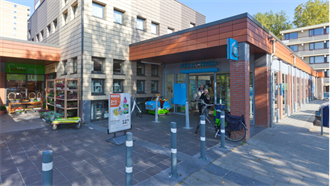Is being flexible just a coping mechanism for a crisis, or can office landlords use it to boost the potential of their portfolios? Newly founded firm infinitSpace believes it has the answer.
At this point, it hardly needs saying the pandemic has wrought major change in the world of work. Demand for office space across Europe has been disrupted, adoption of technology for remote working has fast-forwarded by half a decade at least, and employees have new expectations of their workspace. The environment has evolved, and office providers can either thrive, or risk being left behind.
During the past 18 months, landlords have had little choice but to be flexible, in order to survive a Covid-19 storm. Demand for workspace plummeted 35% in Europe during 2020, according to Savills. Meanwhile, in leading markets such as the UK, some landlords faced cash-flow crises when governments slapped moratoriums on evictions of commercial tenants.
But as business and societies emerge from the pandemic, fresh opportunities arise. After more than a year of being forced into sub-optimal activities such as negotiating rental concessions, landlords can finally make being flexible work for them.
Why? Demand for flexible office space has shown eye-catching growth, this year. Leading broker CBRE reports it regularly completes more than 5x the number of monthly flexible transactions with tenants in the UK, than before the pandemic. Meanwhile, flex space requirements since Q2 this year are consistently double their pre-2020 levels.
Looking longer term, JLL recently released a study predicting that by the start of the next decade, 30% of all office space globally shall be flexible. Tenants’ expectations are changing fast, too. British property agency, Carter Jonas, reported demand for prestigious Grade A workspaces in London rose earlier this year, as new offices which were developed during the 2019 construction cycle, became available. Elsewhere, research by Knight Frank recently found that 47% of UK businesses envision their property strategies will feature more flexible space.
Optimising space
Now could be a good time for landlords to think about evolving their portfolio, with pent-up demand for office space predicted to boom during the rest of 2021 and beyond, as staff slowly return to work.
So, how to capitalise? One option for landlords is to transform flexibility from a crisis-management mantra into a money-maker, by adding a flexible component to their traditional office buildings.
So what is the process of turning part of an asset into flex-office? If only it was as simple as chopping it up into small segments. But making flexibility work has its own demands.
Important issues include working out how much space should become flexible. What about future demand, and handling the sales and marketing activity? Day to day, welcoming a stream of flexible occupiers will bring extra paperwork, maintenance duties and more.
This could be a lot. Traditional office owners may feel they already have enough on their plate. However, there’s a big ‘but.’ A large asset which is almost deserted, perhaps because the occupier has embraced hybrid working – whereby staff may spend more than half of the working week out of the office – contains potential for lucrative revenue growth.
New era
Founded early this year, when the European office market was in the grip of Covid chaos, infinitSpace calls itself the continent’s first operating platform of ‘flex-space as a service.’ The new Israeli-Dutch company deals with all the pain-points which face landlords when embracing flex-space. CEO, Wybo Wijnbergen, was previously a managing director at co-working giant, WeWork. He set up infinitSpace with two fellow co-founders.
Operators like infinitSpace which believe the future of office is flexible, often harness digital tech, in order to aid the process of identifying and converting a portion of an asset into a flexible space. InfinitSpace takes care of the entire process, consulting the landlord on conceptualisation, drawing up a floor plan, character and design, the fit-out and then the marketing.
Does this management company for a new era have advice for traditional office owners? ‘Landlords, even those with zero experience in the flex-office market, can gain workspace rental revenues through their own flexible workspace brand,’ says Wijnbergen. However, research indicates tenants’ space needs will be different than before March 2020.
Hybrid working is expected to become a lasting legacy of Covid-19. The Chartered Management Institute (CMI) in the UK recently found that more than half (56%) of mid-seniority employees want to be in the office just two days a week. Otherwise, forty percent of middle managers said they are likely to start looking for a new job.
At the same time, demand for hybrid work is also a factor in the non-stop war for talent. Forty four percent of Gen Z and Millennials will look to quit a job which fails to enable hybrid working, says CMI.
Being able to adapt quickly as new trends like this develop, is likely to be a strength for landlords. But accurately forecasting tenant demand is challenging – especially in the volatile environment of H2 2021.
On the plus side, recent technological innovations means there are more tools than ever for deeply understanding how tenants use a building, and where opportunities lay for maximising an asset’s potential.
When a landlord decides to go flexible, infinitSpace produces a move in-ready space. This makes sense; the longer swathes of an office sit deserted, the more the opportunity cost mounts for the landlord of sticking to business as usual.
Once the flexible workspace has been devised and built, the landlord can begin welcoming flexible tenants while infinitSpace discreetly manages its operations, all under the landlord’s own brand name.
Tech tools
Managing the complexity of multiple tenants using the space for one day, one week, or a month, is done via an end-to-end software operating system that infinitSpace installs and operates. Indeed, the app can run the entire building and not only the flex space, which is welcome extra functionality.
It can provide 150 different reports, capturing data on occupancy, how users interact with the space and also crucial wellbeing metrics. Being proactive about employee health looks set to be another legacy of the pandemic, which users will take more seriously than ever. From infinitSpace, the landlord gets key insights in an easy-to-understand format, with no need to crunch data.
For users, there is an intuitive app which connects the workspace with the community in which the building is situated. Staff can shop for deals in the neighbourhood, order food to the office, book a cab and even organise events, using the app. This type of functionality can help forge links between the flexible workspace and the local community.
‘On the occupier side, we’ve learnt that we can work remotely, and productivity remains more or less the same,’ says Wijnbergen. ‘So, to get employees back to the office, you may need to provide a great, or even a magical experience. Traditional office space isn’t going to pull them back in. The office needs to be able to personalise and to adapt. Therefore, an end-to-end operating system for the physical workspace is something any landlord should have, in order to meet occupiers’ needs in the coming years.
‘Just doing what you have always done, won’t drive you forward in future, not if your clientele is looking for space that actually evolves with demand and has an improved experience.’
The future of the office market looks as volatile today as it has done in years. But also within closer reach than ever is the chance for landlords to evolve and profit from being flexible.
***************
infinitSpace Fact File
FOUNDERS: brothers Wybo (CEO) & Wilco Wijnbergen (CTO) and Elad Hod (CGO)
TOTAL SPACE: infinitSpace to operate circa 100,000 sq ft by end of this year
FUNDING: Seed round of €1 mln in March of 2021
COUNTRIES ACTIVE: Operates in eight leading European cities and Tel Aviv, IsraelGOAL: Aims to operate in 300 locations by the end of 2025, circa 6,000,000 sq ft in total


































